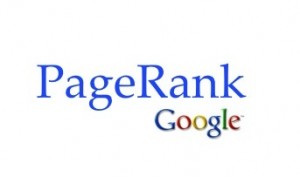 |
PageRank (PR) is an SEO valuation method, used by Google, to compare websites. It is a grading system and is different from SERP (Search Engine Results Page).
PR is a numerical grade from 0-10 used to establish the relative “worth” or importance compared to other, similar webpages. 0 is a poor grade and 10 is the best. I believe only two sites are “10’s”; Google and Facebook.
A Man Named Page
The PageRank algorithm was actually created by an individual named Larry Page. It is patented by Stanford University and licensed by Google. (This was news to me!)
The algorithm used to establish ranking uses several variables, but is essentially based upon the number, and quality, of inbound and outbound links to and from your website.
Links Are Votes
Inbound links are hyperlinks from other sources leading TO your webpage. Outbound links are hyperlinks FROM your site to another page.
In this context, links are viewed as votes, or endorsements, for another site. For instance, if your page has multiple links arriving from other sites and those sites have a higher PR than yours, your site PageRank will improve.
On the other hand, if your page has multiple links from other sources of inferior grade, your pagerank may actually drop. Also, if your outbound links are to real duds…your PR may drop, so choose your links carefully. Link to known, reputable sources.
Reputation and Relevance
Google’s quest is to find the best websites relevant to a keyword search (i.e. your question or phrase you are “Googling?). The algorithm values incoming links from reputable websites, that is, incoming links from websites of similar relevance (subject matter) are weighted heavily.
Why?
My website on retinal diseases is a health related site (BTW, this is actually a backlink from this site to my retina site). While I may claim (using health related keywords, meta tags, titles, etc.) to be a health related site, a better endorsement of my site is when other health related sites, especially of higher PR, link to mine. These are quality links: similar type of site and of higher PR.
As a consequence, this cuts down on the spammers and makes it harder for poor quality sites to get your attention when using link farms (mass quantity links of little relevance or quality).
What Can You Do?
Most likely, it will take 6 months to a year to gain a PR of 1. One other criteria for PR is age of the site (and also the duration for which you purchased your URL – 5 years is great). This “trust” variable is used to combat spammers (those trying to get high rankings but only for a short, short time).
As a small business (i.e your medical practice), a PR of 2 is more than adequate.
I use a free plug-in called SEOquake to check pageranks. It also gives me my Alexa ranking and the number pages indexed by Google. It’s free. Many others exist.
A good PR improves your ability to rank well on SERP (your ultimate goal). Your page should rank higher than pages with similar content if the PR is higher. It’s that simple.
Often, I will “guest post” as a method of building links. Within my post, I’ll have a few links back to my own site, yet this post will be published on a site … with a higher PR than mine!
To Your Growth And Success!
Randy
Randall V. Wong, M.D.
Medical Website Optimization
www.MedicalMarketingEnterprises.com